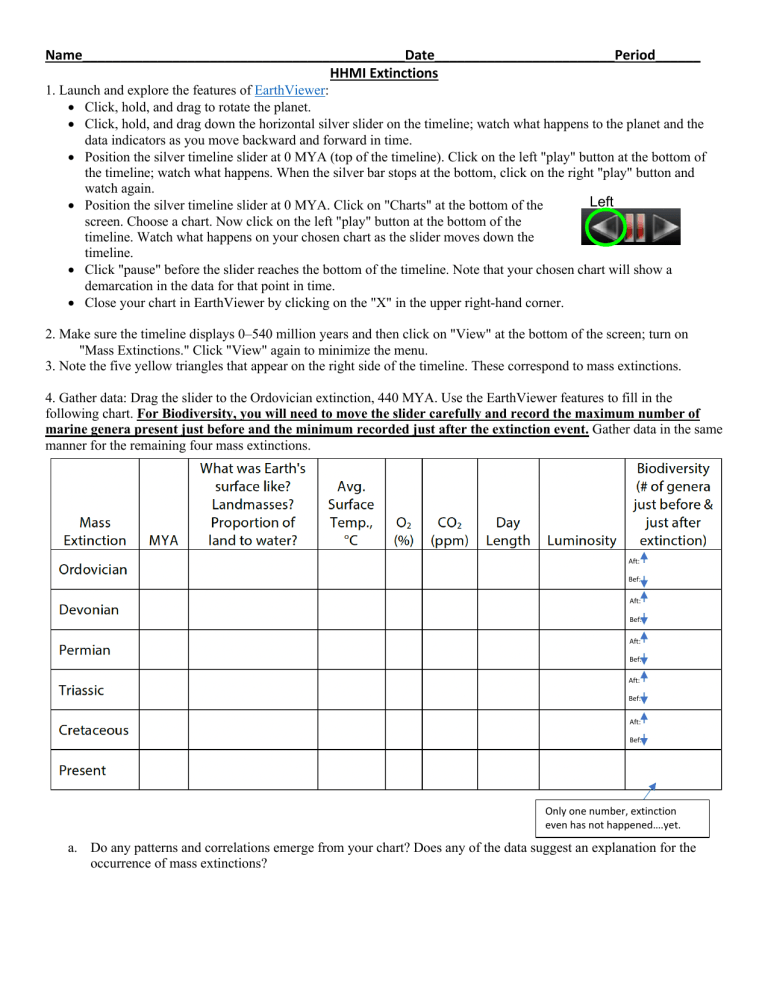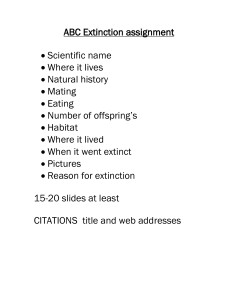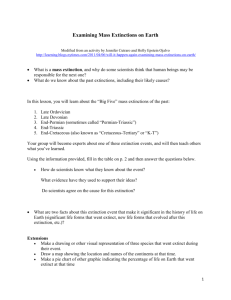
Name___________________________________________Date________________________Period______ HHMI Extinctions 1. Launch and explore the features of EarthViewer: • Click, hold, and drag to rotate the planet. • Click, hold, and drag down the horizontal silver slider on the timeline; watch what happens to the planet and the data indicators as you move backward and forward in time. • Position the silver timeline slider at 0 MYA (top of the timeline). Click on the left "play" button at the bottom of the timeline; watch what happens. When the silver bar stops at the bottom, click on the right "play" button and watch again. Left • Position the silver timeline slider at 0 MYA. Click on "Charts" at the bottom of the screen. Choose a chart. Now click on the left "play" button at the bottom of the timeline. Watch what happens on your chosen chart as the slider moves down the timeline. • Click "pause" before the slider reaches the bottom of the timeline. Note that your chosen chart will show a demarcation in the data for that point in time. • Close your chart in EarthViewer by clicking on the "X" in the upper right-hand corner. 2. Make sure the timeline displays 0–540 million years and then click on "View" at the bottom of the screen; turn on "Mass Extinctions." Click "View" again to minimize the menu. 3. Note the five yellow triangles that appear on the right side of the timeline. These correspond to mass extinctions. 4. Gather data: Drag the slider to the Ordovician extinction, 440 MYA. Use the EarthViewer features to fill in the following chart. For Biodiversity, you will need to move the slider carefully and record the maximum number of marine genera present just before and the minimum recorded just after the extinction event. Gather data in the same manner for the remaining four mass extinctions. Aft: Bef: Aft: Bef: Aft: Bef: Aft: Bef: Aft: Bef: Only one number, extinction even has not happened….yet. a. Do any patterns and correlations emerge from your chart? Does any of the data suggest an explanation for the occurrence of mass extinctions? b. Calculate the biodiversity loss in each extinction and report in terms of percent. Use the equation below. 𝑎𝑓𝑡𝑒𝑟 ! ) × 100 = 𝑏𝑖𝑜𝑑𝑖𝑣𝑒𝑟𝑖𝑠𝑡𝑦 𝑙𝑜𝑠𝑠 𝑏𝑒𝑓𝑜𝑟𝑒 % of Life Remaining ***Keep things easy. Round all percentages to the nearest whole number! c. What questions do you now have about mass extinctions? 5. Return to EarthViewer. Move the slider down to "Cretaceous extinction" and click on the link. Read the information about this extinction (formally known as the Cretaceous-Paleogene or sometimes the Cretaceous-Tertiary extinction). 6. The information tells you that "overwhelming evidence suggests that there was an extinction event that was caused by a 10-km-diameter asteroid that struck Earth." Suggest at least three lines of evidence that might have led scientists to this conclusion. Discuss your predictions with your table partner and record your ideas in the space below. 7. Together with your class, watch the film, The Day the Mesozoic Died (0:00 -15:25). As you watch, answer the questions below. a. What piece of evidence initially convinced Dr. Alvarez that a mass extinction had occurred at the K-T boundary? b. What was the first clue that an asteroid had struck Earth at around the same time as the mass extinction? 7. Look again at your calculations in the chart of 4b. Which extinction even was the worst? What was it thought to be caused by? And how did it change the Earth? (Hint: you can always go back to the interactive, click the extinction title and read about it) 8. Let’s dig a little deeper into this extinction event. Read the Stanford Earth Matters magazine article “What caused Earth’s biggest mass extinction?” and answer the questions on the following page. https://earth.stanford.edu/news/what-caused-earths-biggest-mass-extinction#gs.nwupeo a. What is the nickname for the Permian Extinction? _____________________________ b. The oceans suffered great loss of life. New Research suggests the high casualty could be blamed on the metabolism of marine animals. Explain how. c. What ocean species suffered the most from this event? Ones near the tropics or ones at the poles? d. Global warming leading to insufficient oxygen explains more than half of the marine diversity losses. What are two other results that “likely acted as causes”? e. Extended thinking question. Why are scientists worried about our current global warming problem with that of the Permian? Use data from the article to support your answer. 9. Let’s go back to the video The Day the Mesozoic Died (15:25 -32:35). What additional observations and findings supported the asteroid-impact hypothesis by evidence of the incredible heat the impact would have created? 10. Which piece of evidence definitely showed that an asteroid had struck Earth? Explain your answer. 11. How does the asteroid-impact hypothesis explain the extinction of the dinosaurs and other species? How did the collision affect Earth and how did that affect the species and the food chains? 12. Many different pieces of evidence lead to the formation of the asteroid hypothesis and provided support for the hypothesis, including a. Finding tsunami deposits in the Brazos River Basin, Texas. b. Determining that rocks taken from the Chicxulub crater are the same age as the K-T boundary. c. Discovering gravitational field anomalies on the Yucatan peninsula, from surveys done for oil exploration. d. Finding high levels of iridium in the K-T boundary layer. e. Identifying spherules and shocked quartz in Haiti. f. Finding that an isotope of plutonium is not in the K-T boundary layer. g. Observing differences in foraminifera fossils above and below the K-T boundary layer. i. For i-iii, write the letter on the line that corresponds to the evidence that best fits the description. Which piece of evidence (a-g) lead scientists to conclude that the cause of the K-T boundary layer was extraterrestrial in nature? _____ ii. Which piece of evidence (a-g) lead scientists to dismiss the supernova hypothesis? ____ iii. What was the “ultimate” piece of evidence (a-g) that supported the hypothesis that an asteroid had struck Earth 66 million years ago? _____





